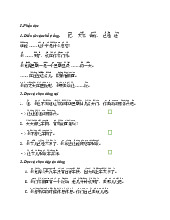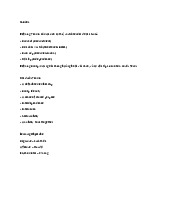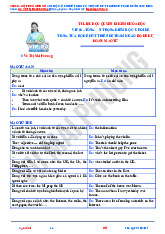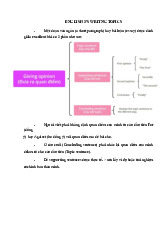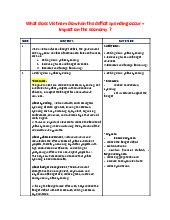









Preview text:
lOMoARcPSD|49830739 Date of teaching Class 10A 10A 10A REVIEW 3.1 Lesson 1 - Language I. OBJECTIVES
By the end of this lesson, Ss will be able to: 1. Knowledge
- Revise the language and Ss have learnt in Units 6-7-8; underline the stress words in each
sentences; do exercises about relative pronoun; rewrite the sentences using comparative
and superlative or the passive voice without changing their meaning - Summarise Ss’
answers and add some more information if necessary. 2. Core competence
- Develop communication skills and creativity;
- Develop critical thinking skills;
- Be collaborative and supportive in pair work and team work;- Actively join in class activities. 3. Personal qualities - Develop self-study skills. II. MATERIALS
- Grade 10 textbook, Review 3
- Computer connected to the Internet
- Projector / TV/ pictures and cards - hoclieu.vn III. PROCEDURES 1.
WARM-UP (5 mins) a. Objectives:
- Revise what students have learnt in the three units. - To
enhance students’ skills of cooperating with teammates. b. Content: - Game: Listing c. Expected outcomes:
- Students can remember all about stress words, about relative pronoun and vocab related to topics in Units 6,7,8. lOMoARcPSD|49830739 d. Organization
TEACHER’S AND STUDENTS’ ACTIVITIES CONTENTS WARM-UP: BOARD RACE Suggested answer: -
T splits the class into teams and gives each Unit 6 Unit 7 Unit 8
team a colored marker. T creates 3 columns on the gender Enter Face to face
board and writes 3 topics at the top of each column. T
asks Ss to write as many words as possible related to equality Promote strategy
the 3 topics. - Ss work in groups, write as many words Surgeon Aims Online
as possible related to the topics in the form of a relay learning race. - T and Ss discuss the answers. kindergarten commit Blended -
T checks the answers as a class. (Each team learning
wins one point for each correct word. Any words that
are unreadable or misspelled are not counted.) e. Assessment
- Teacher observes the groups and gives feedback.
2. ACTIVITY 1: PRONUNCIATION (6 mins) a. Objectives:
- To give Ss an opportunity to review stressed words. b. Content:
- Review stress in three-syllable adjectives and verbs, stress in words
with more than three syllables, and sentence stress; c. Expected outcomes:
- Students can practise speaking with the stress words in each
sentences.d. Organization
TEACHER’S AND STUDENTS’ ACTIVITIES CONTENTS
Read the following sentences. Underlined the stressed words in each sentences then mark the
stressed syllables in these words. (6 mins) -
T asks Ss to read the sentences, underline the Key:
stressed words, and then mark the stressed syllables. 1.
Our responsi'bility is to help the -
Ss work in pairs and do as instructed.
'children in re'mote ‘areas. -
T plays the recording, pausing after each 2.
Viet Nam is an 'active 'member of
sentence forSs to check their answers.
‘many inter'national organi'sations. -
T checks answers as a class by asking 3.
Our 'company has gained eco'nomic
individual Ss to write the sentences, underline the
'benefits from 'selling 'local 'products.
stressed words and mark the stressed syllables. 4.
There are many new ‘learning
ac’tivities at schools now. e. Assessment
- Teacher obverses Ss’s work and gives feedback.
2. ACTIVITY 2: VOCABULARY (29 mins) a. Objectives:
- To help Ss review the collocations they have learnt in the previous units and practise using
the words in meaningful contexts. b. Content:
- Task 1. Match the words that go together. (p.96)
- Task 2. Complete the sentences with the correct form of the words in brackets (p.96) c. Expected outcomes: lOMoARcPSD|49830739
- Students can use all the vocabulary they have learnt in the three units to complete the tasks.d. Organization
Task 1: Match the words that go together. (7 mins) -
T asks Ss to work individually to match the Answer key:
words. T elicits the unit each phrase comes from or the 1. c 2. d 3. a 4. b topic it is related to.
E.g. 1. equal opportunities (Unit 6: Gender equality). -
Ss do this exercise individually by matching the words that go together. -
Ss compares their answers with their
deskmates.- T checks answers as a class. T calls on one
student to read an adjective aloud and another student to
read the noun that goes with it.
Task 2: Complete the sentences with the correct form of the words in brackets (6 mins) -
T asks Ss to work individually to complete the Answer key:
sentences with the correct forms of the words. T tells 1. equally 2. Organisations
them to read the sentences, focus on the words around
3. traditionally 4. Education
the gaps and decide on the part of speech that they need
to use to complete them. T explains that they have to use
the context clues to decide on the word form. -
Ss work individually to complete the task. -
T allows Ss to share answers before discussing as a class. -
T checks answers as a class. T has Ss call out the
word they have used for each sentence first, asks some
Ss to read the complete sentences. T confirms the correct answers. e. Assessment
- Teacher obverses Ss’s work and gives feedback.
3. ACTIVITY 3: GRAMMAR (16 mins) a. Objectives:
- To help Ss revise the relative pronouns who, that, which and whose and revise comparative
and superlative adjectives, and the passive voice with modal verbs. b. Content:
- Task 1. Choose the best relative pronoun to complete each sentences. (p.97)
- Task 2. Rewrite the sentences using comparative and superlative adjective or the passive voice
without changing their meaning. (p97) c. Expected outcomes:
- Students can use best relative pronoun, comparative and superlative adjectives, and the
passive voice with modal verbs to complete the tasks. d. Organization
Task 1: Choose the best relative pronoun to complete each sentences. (6 mins) -
T asks Ss to work independently to choose the Suggested answers:
correct relative pronouns to complete the sentences. -
Ss read the sentences first and decide the best
relative pronouns to complete the sentences. 1. A 2. A 3. C 4. B -
Ss compare the answers with their deskmates. lOMoARcPSD|49830739 -
T checks answers as a class. T can ask Ss to read
aloudthe full sentences and corrects their pronunciation if needed.
Task 2: Rewrite the sentences using comparative and superlative adjective or the passive voice without
changing their meaning. (10 mins) -
T has Ss work in pairs, rewriting the sentences
1. is larger than 2. can’t be accepted 3.
using comparative and superlative adjectives or the
is more active 4. the most interesting
passive voice without changing their meanings. T tells online course
them to read each sentence carefully and decide which
5. should be provided for women structure they should use. - Ss do the task in pairs. -
T calls on individual Ss to read their completed sentences -
T checks as a class and confirms the correct answers. e. Assessment
- Teacher obverses Ss’s work and give feedback.
4. CONSOLIDATION (3 mins) a. Wrap-up
- T asks Ss to talk about what they have learnt in the lesson.b. Homework - Do exercises on workbook. - Prepare for Skills 1. lOMoARcPSD|49830739 Date of teaching Class 10A 10A 10A REVIEW 3.2
SKILLS: LISTENING & SPEAKING I. OBJECTIVES
By the end of this lesson, Ss will be able to: 1. Knowledge
- Revise the listening skills for main and specific information and improve speaking skills of discussion.
- Summarise Ss’ answers and add some more information if necessary. 2. Core competence
- Develop communication skills and creativity;
- Develop critical thinking skills;
- Be collaborative and supportive in pair work and team work;- Actively join in class activities. 3. Personal qualities - Develop self-study skills. II. MATERIALS
- Grade 10 textbook, Review 3.2
- Computer connected to the Internet
- Projector / TV/ pictures and cards - Hoclieu.vn III. PROCEDURES 1.
WARM-UP (5 mins) a. Objectives:
- To stir up the atmosphere and activate students’ knowledge
on a basic life skill;- To set the context for the speaking part; b. Content:
- Choosing the essential things to live on an island alone. c. Expected outcomes:
- Students choose and explain why they choose those things. d. Organization
TEACHER’S AND STUDENTS’ ACTIVITIES CONTENTS
- T gives Ss a theme “Devices which are helpful for Suggested answer:
online learning”. T writes the letters A to Z (in lOMoARcPSD|49830739
columns) on the board. T asks Ss to write an appropriate Lap top, PC, Computer, Television, Mobile
word next to each letter on the board (For example: phone ...)
Computer, Television, Mobile phone ...) -
Teams of Ss must race to write an appropriate
wordnext to each letter on the board. - T and Ss discuss the answers. -
T checks the answers as a class. e. Assessment
- Teacher observes the groups and gives feedback.
2. ACTIVITY 2: LISTENING (15 mins) a. Objectives:
- To help students revise the listening skills for main and specific
information.b. Content:
- Task 1: Listen and choose the best title for the talk. (p.97)
- Task 2: Listen again and complete each sentence with ONE words. (p.97) c. Expected outcomes:
- Students use all the skills to do the exercises.d. Organization
TEACHER’S AND STUDENTS’ ACTIVITIES CONTENTS
Task 1: Listen and choose the best title for the talk. (7 mins) -
T asks Ss to look through the list of titles. Key: B -
Ss look at three options, read, and underline key
words.- T plays the recording once for Ss to listen and choose the best answer. -
T checks the answers as a class. T asks Ss to
explain why A and C are not suitable titles. E.g. (A) The
recording talks about using electronic devices to study
English so this option is too general; (C) Ways to do
online exercises are not mentioned in the recording.
Task 2: Listen again and complete each sentence with ONE words. (8 mins) -
T asks Ss to look at the sentences, underline the Key:
key words and decide what part of speech they need to fill 1. bored 2. useful
in each blank (e.g. 1: adj; 2: adj; 3: noun; 4: noun). 3. activities 4. Answers -
T plays the recording again and has Ss write down
their answers in their notebooks. -
Ss work in pairs to compare their answers. -
T checks the answers as a class. Tapescript:
You may feel unhappy with your low scores in English tests or bored with textbooks, lectures, and
other traditional teaching materials. Want to learn English in a different but effective way? The answer
is so simple: use electronic devices to study English online!...
There are many useful websites to learn English on the Internet. All you need is a computer with an lOMoARcPSD|49830739
Internet connection. Type in a topic you want to learn about, and press Enter. A list of websites will
appear on your screen. Click the links to choose the ones you find interesting. Don't worry if some
words are not familiar to you. You can find their meanings in online dictionaries. There are also sites that
offer interesting grammar lessons, and fun activities for improving your vocabulary, pronunciation and
listening skills. You can do exercises or take free tests, and check your answers immediately. e. Assessment
- Teacher observes the groups and gives feedback.
3. ACTIVITY 3: SPEAKING (20 mins) a. Objectives:
- To provide an opportunity for Ss to practice expressing opinions about the advantages of
learning English and other subjects online. b. Content:
- Task 1: Work in pairs. Share your opinions about the advantages of learning English and other subjects online.(p.98) c. Expected outcomes:
- Students use all the skills to do the exercises. d. Organization
Task 1: Work in pairs. Share your opinions about the advantages of learning English and other
subjects online. (10 mins) -
T asks Ss to work in pairs to share their opinions
Suggested ideas for discussion
about the advantages of learning English and other
subjects online. T asks Ss to read through the useful -
I think online learning is more
expressions and the example. T checks Ss’ understanding. effectivebecause you can revise the lesson
- Ss work in pairs, expressing opinions about the
many times everywhere you want.
advantages of learning English and other subjects online.
- T calls on two or three pairs to share their opinions with -
Online learning gives us a chance the class.
tostudy with our own scheduled plan. -
T comments Ss’ answers, praises for interesting ideas and fluent delivery. -
Online courses have easy access tolearning materials. e. Assessment
- T gives comments and feedback students’ answers.
4. CONSOLIDATION (3 mins) a. Wrap-up
- T asks Ss to talk about what they have learnt in the lesson.b. Homework (2
mins) - Do exercises on workbook.
- Prepare for Review 3.3: Skills 2 Date of teaching Class 10A 10A 10A REVIEW 3.3
SKILLS: READING AND WRITING lOMoARcPSD|49830739 I. OBJECTIVES
By the end of this lesson, Ss will be able to: 1. Knowledge
- practice reading for main idea and specific information.
- Summarize Ss’ answers and add some more information if necessary. 2. Core competence
- Develop communication skills and creativity;
- Develop critical thinking skills;
- Be collaborative and supportive in pair work and team work;- Actively join in class activities. 3. Personal qualities - Develop self-study skills. II. MATERIALS
- Grade 10 textbook, Review 3
- Computer connected to the Internet
- Projector / TV/ pictures and cards - Hoclieu.vn III. PROCEDURES 1.
WARM-UP (5 mins) a. Objectives:
- To check the knowledge about rugby and international organisations and lead in new lesson.
- To set the context for the reading part;b. Content: - Songs c. Expected outcomes:
- Students are excited to start the lesson. d. Organization
TEACHER’S AND STUDENTS’ ACTIVITIES CONTENTS
-T asks Ss to work in pairs and answer questions about Suggested words:
rugby and international organisations - Ss do as
1. In which country did rugby originate? instructed. A. Canada B. England C.
- T calls Ss to give their answers to each questions. Pakistan D. New Zealand
- T checks answers as a class.
2. What shape is a rugby ball? A. Perfectly round B. Round with lOMoARcPSD|49830739 divots, like a big golf ball
C. Oval D. Oval with pointed ends, like a U.S. football
3. What is the traditional/ British word for a rugby field? A. A rhomboid B. A rugger C. A venue D. A pitch
4. This organization, formed in 1949, is a
military alliance among various North American and European states. A. NATO B. ANZUS C. SEATO D. OECD
5. Where are the headquarters of the United Nations? A. Belgium B. Switzerland C. New York D. France Key: 1. B 2. C 3. D 4. A 5. C e. Assessment
- Teacher observes the groups and give feedback.
2. ACTIVITY 1: READING (15 mins) a. Objectives:
- To help Ss practice reading for main idea and specific information.b. Content:
- Task 1: Read the text and match the highlighted words with their meanings. (p.98)
- Task 2: Read the text again and decide whether the statements are true (T) or
false (F). (p.99) c. Expected outcomes:
- Students can use all the skills to complete the tasks successfully.d. Organization
Task 1: Read the text and match the highlighted words with their meanings. (7 mins) -
T asks Ss to read the whole text once to get an Key: 1. qualified 2. encourage 3.
overall idea. T has Ss read the text again. T tells them to considered
pay attention to the context of each highlighted word,
then look at the three definitions. -
Ss work individually to work out the words. -
T puts Ss into pairs to compare their answers and
asksindividual Ss to write the words on the board. -
T checks the answers as a class.
Task 2: Read the text again and decide whether the statements are true (T) or false (F). (8 mins) -
T asks Ss to read the statements and underline the Key:
key words. T checks what key words they have 1. F 2. T 3. T 4. F
underlined, e.g. 1. male, trained, become, rugby coaches,
Fiji; 2. Kitiana, working, primary school; 3. Kitiana,
qualified coach, rugby programme; 4. rugby, other sports,
can’t, change, behaviour, males and females. -
Ss read through the text to locate the answers, and
decide which statements are true or false. lOMoARcPSD|49830739
- T calls on some Ss to write their answers on the board. -
T checks the answers as a class. e. Assessment
- Teacher observes the groups and gives feedback.
2. ACTIVITY 2: WRITING (20 mins) a. Objectives:
- To help Ss practise writing a paragraph about an international
organisation.b. Content:
- Task 1: Write a paragraph (120-150 words) about an international
organization you have learn about (UN, UNICEF, WTO). Use the outline
below to help you. (p.99) c. Expected outcomes:
- Students complete the task successfully.d. Organization
Task 1: Write a paragraph (120-150 words) about an international organization you have learn about
(UN, UNICEF, WTO). Use the outline below to help you. (8 mins) -
T tells Ss they are going to write a paragraph (120 Sample answer:
– 150 words) about an international organization that they UNICEF, also United Nations Children’s have learnt in Unit 7.
Fund, was formed in 1946. It works in -
T asks Ss to read through the questions and
over 190 countries to help improve health
brainstorm some ideas for their writing in groups.
and education of children. Its main aims is -
T asks Ss to use the given outline. They should
to support the most disadvantaged
pay attention to punctuation, structures, word choice, linking words, etc.
children all over the world. In Viet Nam, -
Ss work individually and write the paragraph.- T
UNICEF aims to protect children and
gives Ss enough time to complete the paragraph. T walks
make sure they are safe and healthy, and
round the class and offers help.
have access to education. UNICEF has -
T asks individual Ss to read their paragraphs or
brought many positive changes to
collects them to check after class and provides written
Vietnamese children’s lives. feedback. e. Assessment
- T gives comments and feedback to all presentations, and awards a prize to the group which has the most votes.
4. CONSOLIDATION (5 mins) a. Wrap-up
- T asks Ss to talk about what they have learnt in the lesson.b. Homework - Do exercises on workbook. - Prepare for Unit 9.
